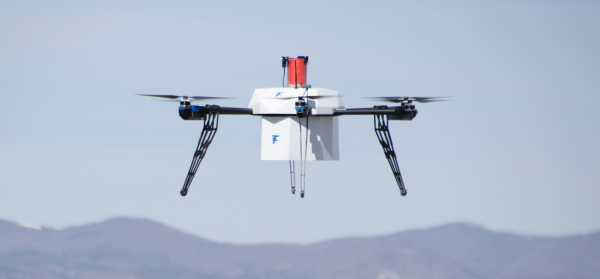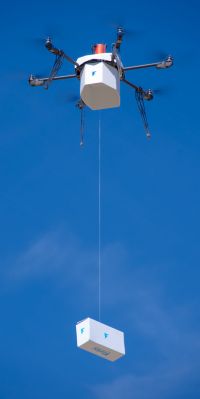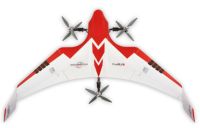Podcast: Play in new window | Download (Duration: 30:26 — 20.9MB)
The proposed BREEZE drone for Venus, a tethered drone for first responders, river rescue missions, taking out drones with Thor’s hammer, UAS over the Arctic, drone deliveries to offshore wind farms, and hobby drones in Ukraine.
UAV News
NASA considers bird-like drones to explore Venus’s atmosphere
NASA wants to study the use of drones that fly through the Venusian atmosphere and study the planet. BREEZE, or Bioinspired Ray for Extreme Environments and Zonal Exploration, will be funded for a two-year concept study. The BREEZE drones would be inflatable, fly at altitudes between 50-60 km, and ride zonal winds. This is one of 17 proposals under the NASA Innovative Advanced Concepts (NIAC) program.
Video: BREEZE | A Revolutionary Ray-inspired Airship Concept for Aerial Venus Exploration
NCDOT launches national first with tethered drones on IMAP Trucks
Three years ago, in episode 285, we covered the Fotokite tethered drone and their partnership with Pierce Manufacturing. Now we see that the North Carolina Department of Transportation is launching a pilot with Fotokite. Some IMAP (Incident Management Assistance Patrol) vehicles will be fitted with tethered drones to provide situational awareness to the NCDOT Operations and Traffic Management Centers and assist with overall traffic management of the incidents.
Iris Automation receives FAA waiver to test BVLOS drones in Nevada river rescue missions
The Iris Automation waiver allows them to fly BVLOS in a rural, unpopulated area south of Reno, Nevada using the company’s Casia X detect and avoid system. Iris is working with the City of Reno and the Reno Fire Department (RFD) which conducts about 40 rescues per year at the Truckee River.
Killing drones with Thor’s hammer: Air Force eyes counter-UAS ‘Mjölnir’ weapon
The Air Force Research Laboratory (AFRL) has awarded a $26 million counter-UAS contract to Leidos. The company will build a prototype system that disables sUAS with high-power microwaves. Called Mjölnir, the name of Thor’s hammer, it builds on previous work under the Tactical High Power Operational Responder, or THOR, program. THOR is a counter-swarm electromagnetic weapon that uses non-kinetic energy to defeat multiple targets. In 2020, the Defense Department became so concerned it created the Joint Counter-Small Unmanned Aircraft Office, led by the Army.
Earth News: NASA is helping fly drones in the arctic — here’s what that means for sea ice and sea level change
NASA is leading a team to show that a fixed-winged drone could fly over the Arctic ocean for several days. The attritable UAS from Vanilla Unmanned is designed for multi-day surveillance and inspection operations. In this application, a drone with sensors can capture more accurate data than is the case with satellites.
Project Seeks to Build Drones to Supply Offshore Wind Farms
The drones would be customized to deliver supplies and other items to offshore wind farms in the Asia-Pacific region. Two Singapore-based companies signed an MOU to co-develop the drones: Marco Polo Marine Ltd., a regional integrated marine logistics company; and F-drones, developer of large autonomous delivery drones. The delivery drones are expected to reduce cost by 90 percent, be four times faster, and reduce carbon footprint.
Hobby drones at war: How do they help Ukraine?
In a February Facebook post, Ukraine’s Ministry of Defense says it is looking for drones and for pilots: “Do you own a drone? Give it to experienced pilots to use!” and “Do you know how to drive a drone? Join the joint patrol with units 112 of the separate brigade of the city of Kyiv!”
UAV Video of the Week
The PGA Tour is using drones to follow golf shots like this one from Rory McIlroy and it’s so cool


 In Episode 59 we reported that
In Episode 59 we reported that  NASA and the U.S. Air Force Research Laboratory (AFRL) hope to demonstrate the Traveler UAS that can autonomously plan, launch, navigate, and refuel itself. The FAA supports the idea and will use data from the program to help set future standards for UAS operations. A Traveler project demonstration flight outside of restricted airspace is planned for later in 2016. An autonomous mission without a safety pilot could take place in 2017. The demonstrations will use a modified
NASA and the U.S. Air Force Research Laboratory (AFRL) hope to demonstrate the Traveler UAS that can autonomously plan, launch, navigate, and refuel itself. The FAA supports the idea and will use data from the program to help set future standards for UAS operations. A Traveler project demonstration flight outside of restricted airspace is planned for later in 2016. An autonomous mission without a safety pilot could take place in 2017. The demonstrations will use a modified